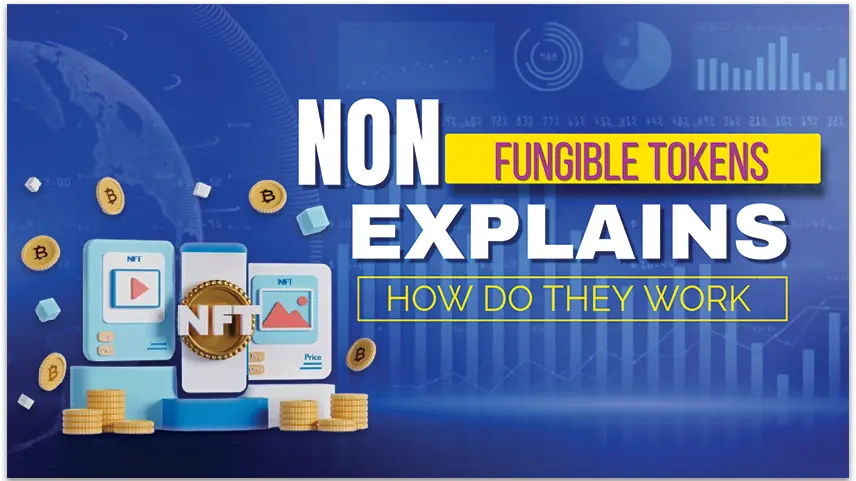Non Fungible Tokens (NFTs) Explain: How Do They Work
Non-fungible tokens, or NFTs, have been making headlines in the world of blockchain technology. But what exactly are Non fungiable tokens, and how do Non fungiable tokens work? This article will provide a breakdown of the basics of NFTs and their role in the digital world.

What is Non Fungible Tokens meaning?
Non-fungible tokens means unique digital assets that are stored on a blockchain. Unlike cryptocurrencies such as Bitcoin, which are fungible and can be exchanged for one another, Non Fungible Token technology or NFTs are one-of-a-kind and cannot be replicated. They can denote anything from digital art and music to virtual real estate and collectibles. Non Fungible Tokens are bought and sold using cryptocurrency, and ownership is recorded on the blockchain, making them transparent and secure.
How do NFTs work?
NFTs work by using blockchain technology to create a unique digital asset that cannot be replicated or duplicated. Each NFT has a unique identifier that is recorded on the blockchain, which serves as a public ledger of ownership. When an NFT is bought or sold, the transaction is recorded on the blockchain, making it transparent and secure. NFTs can represent anything from digital art and music to virtual real estate and collectibles, and they are bought and sold using cryptocurrency. As the popularity of NFTs continues to grow, they are becoming an increasingly important part of the blockchain ecosystem.
When the any new technology invented in this world, it contains own special features, PROS and CONS. Similarly, NFTs has alos its specific features, PROS and CONS.
Features of Non Fungible Tokens
The features of Non Fungible Tokens are mentioned below:
NFTs are created using blockchain technology, which ensures that each token is verified and cannot be duplicated or counterfeited.
NFTs can express a broad medley of digital assets, including artwork, music, videos, and even tweets or memes.
NFTs are bought and sold on digital marketplaces, often using cryptocurrency as the payment method.
The value of an NFT is determined by supply and demand, and can fluctuate based on factors such as the popularity of the artist or the perceived rarity of the asset.
NFTs can have additional features built in, such as royalty payments for the original creator whenever the token is resold in the future.
NFTs have gained popularity in art as a way for artists to monetize their digital designs and verify ownership over them.
NFTs have also been criticized for their potential environmental impact due to the energy-intensive process of creating and verifying blockchain transactions.
Non Fungible Token Pros and Cons
Non Fungible Token Pros and Cons are explained below.
Pros of NFTs:
Unique digital ownership: NFTs allow creators to sell unique digital assets that can be owned and verified on the blockchain.
Revenue streams: NFTs offer new ways for creators to monetize their digital content and earn income.
Increased authenticity: NFTs can help to reduce the risk of fraud and piracy by providing a way to verify the authenticity of digital assets.
Collectibility: NFTs can be used to create unique and collectible digital items that can increase in value over time.
Transparency: Transactions involving NFTs are recorded on the blockchain, which provides transparency and a secure record of ownership.
Cons of NFTs:
Environmental impact: The process of creating and trading NFTs requires a powerful dose of energy, which can have a harmful impact on the environment.
Speculation: The value of NFTs can be highly speculative and may not always be tied to the underlying value of the asset.
Exclusivity: NFTs can be expensive, which can make them exclusive to a select few and limit access to certain digital content.
Legal issues: Ownership and copyright issues can arise with NFTs, especially when it comes to digital content that may have multiple owners or contributors.
Limited practical use: NFTs may not have practical uses beyond the realm of collectibles and art, which can limit their long-term viability.
Non Fungible Tokens Examples in the art world
NFTs have become increasingly popular in art, with many artists using them to sell digital art pieces for large sums of money. One example is the digital artist Beeple, who sold an NFT of his artwork for a record-breaking $69 million at a Christie's auction in March 2021. Other artists, such as Grimes and Trevor Jones, have also sold NFTs of their work for significant amounts. NFTs have also been used to sell virtual real estate, collectibles, and even tweets.
Conclusion
While NFTs have gained popularity in art, their potential uses extend far beyond that. NFTs can be used to confirm ownership and authenticity of any digital asset, from music to video games to virtual real estate. They can also be used to create unique experiences and interactions within virtual worlds. As blockchain technology continues to evolve, it's likely that we'll see even more innovative uses for NFTs in the future.

0 comments